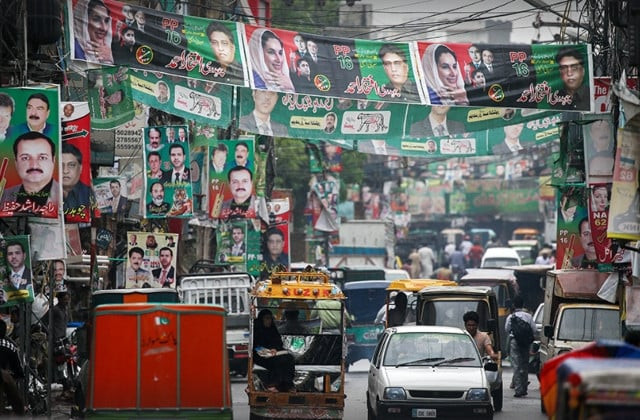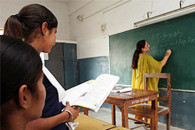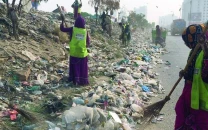Polls laced with unpredictability
Independents may play key role if no party secures decisive majority

The next general elections scheduled on the 8th of this month are poised to be a pivotal chapter in Pakistan's political history, as they are marked by multifaceted challenges and evolving dynamics.
As the nation grapples with its worst economic crisis, security concerns from militant groups, and disillusioned youth, the political stage is set for a complex and intriguing electoral battle.
The security challenges are significant, with the Tehreek-e-Taliban Pakistan (TTP) and Da’esh posing serious threats, especially in Khyber-Pakhtunkhwa, while Baloch militant groups have heightened their activities in various areas of Balochistan.
Against this backdrop, high inflation has struck the common man, creating an environment of economic distress.
The civilian government's space in the decision-making process, particularly in defence and critical foreign affairs, has diminished further with the setting up of the Special Investment Facilitation Council (SIFC), where the military leadership plays a key role in economic matters.
The political landscape has witnessed significant shifts after PTI founding chairman Imran Khan's "one-page" mantra fell out with former army chief Gen (retd) Qamar Javed Bajwa, leading to an opening for the PML-N, which had faced ire of the ‘powerful circles’ in the 2018 elections.
The subsequent 16-month tenure of the Pakistan Democratic Movement (PDM) alliance’s government left the component parties unpopular, especially the PML-N which led it, as it grappled with internal and external challenges.
Imran, despite an unimpressive previous term, regained popularity when the Shehbaz Sharif-led coalition government made unpopular decisions to secure loans from the International Monetary Fund (IMF).
The aftermath witnessed unprecedented economic challenges, including soaring inflation, currency devaluation, and increased utility prices – hitting the already marginalised common man the hardest.
The PTI's protest campaign against its government's ouster culminated in the May 9 and 10, 2023 violence, when the alleged party supporters attacked military installations, escalating tensions with the security establishment to a point of no return in the foreseeable future.
The subsequent crackdown resulted in the imprisonment of key PTI leaders, including Imran, Shah Mahmood Qureshi, and Chaudhry Parvez Elahi.
Read also: Imran, Qureshi sentenced to 10-year imprisonment in cypher case
This incident splintered the PTI into three factions: the PTI-Parliamentarians (PTI-P) led by Pervez Khattak and Mahmood Khan; Istehkam-e-Pakistan Party (IPP) led by Jahangir Khan Tareen and Aleem Khan; and the Pakistan Tehreek-e-Insaf Nazriati (PTI-N) founded by Akhtar Iqbal Dar.
Some PTI defectors either joined other parties or chose to stay away from politics temporarily.
Despite the severe crackdown, the PTI maintains significant public support, presenting a formidable challenge to its opponents, especially the PML-N.
Current political trends reveal that the PML-N, led by its supremo – three-time former premier Nawaz Sharif – is in an advantageous position.
However, uncertainties loom as the party faces challenges forming a government without alliances.
Seat adjustments with smaller parties and groups have required the PML-N to cede critical constituencies, causing discontent among its party activists.
Election surveys, often met with skepticism in Pakistan, highlight the unpredictability of the political landscape.
Gallop, considered relatively credible, contrasts with surveys by other organisations, including the Institute for Public Opinion Research (IPOR), Centre for Public Opinion Research (CPOR), and PATTAN-Coalition-38, creating a diverse set of projections.
As candidates gear up for the elections, the PTI faces adversity in campaigning because of its leader's incarceration and the loss of the party symbol.
Punjab remains a crucial battleground, where the PML-N holds an advantage but is challenged by seat adjustments with the IPP and PML-Q.
Read: Electoral crown jewel Punjab ready for scintillating contests
In K-P, the PTI retains popularity despite hardships, while the PPP seems poised for electoral gains in Sindh, particularly in Karachi.
Balochistan's dynamics remain unique, with the blessings of the ‘powerful stakeholders’ holding significant weight.
Analysts suggest that the PTI holds an edge in K-P and retains popularity in northern Punjab.
However, translating this into votes and seats becomes challenging given the party's current constraints.
The PML-N's dominance in central Punjab is countered by seat adjustments and the emergence of formidable opponents.
The PPP aims to capitalise on the PTI's challenges, especially in southern Punjab.
Sindh appears to be in the PPP's control, with hopes of increasing its National Assembly seats, especially in Karachi.
Balochistan, traditionally influenced by the dynamics of the ‘powerful stakeholders’, foresees a coalition government, possibly led by someone from the BAP.
The complexity of the 2024 elections, with candidates contesting from multiple constituencies, further adds to the unpredictability.
Notable figures like Nawaz; his younger brother and PML-N President, Shehbaz Sharif; his daughter Maryam Nawaz; PPP Chairman Bilawal Bhutto Zardari and others engaging in multiple contests heighten the intrigue surrounding the electoral outcome.
Also read: 30 political bigwigs in the race from K-P
The sheer volume of candidates, with 5,121 contesting for 266 NA seats, raises the stakes. This means there are 19 candidates on an average in a constituency. Of these, only 3,027 are independent candidates.
The independents may play a pivotal role if no party secures a decisive majority.
In big urban centres, including Karachi, there are 581 candidates in the race for 22 NA seats with an average of 26 candidates.
In Lahore, an average of 22 candidates are contesting for each NA constituency. A similar situation is prevalent in other areas, particularly those urban centres that have more voice in national politics. Likewise, 12,695 candidates are competing for seats in provincial assemblies.
Among them, 65% are independent candidates, including the ones backed by the PTI.
In a polarised political environment, it is expected that more independents will win seats in the NA and provincial legislatures.
If no party bags decisive numbers, the role of independents will be crucial in making the government, especially at the Centre.
Smaller parties, including the IPP and PML-Q, are already in league with the PML-N to form a coalition government.
This will bring in many players to manoeuvre the outcome in their favour – possibly allowing many scenarios as far as the next government is concerned.
As the nation braces for these unprecedented elections, uncertainties prevail and as per the historical norm, the final decision rests with the ‘powerful quarters’.
The multifaceted nature of these elections will undoubtedly shape Pakistan's political landscape for the years to come.



















COMMENTS
Comments are moderated and generally will be posted if they are on-topic and not abusive.
For more information, please see our Comments FAQ